英语教学设计投稿模板
- 格式:doc
- 大小:54.50 KB
- 文档页数:5
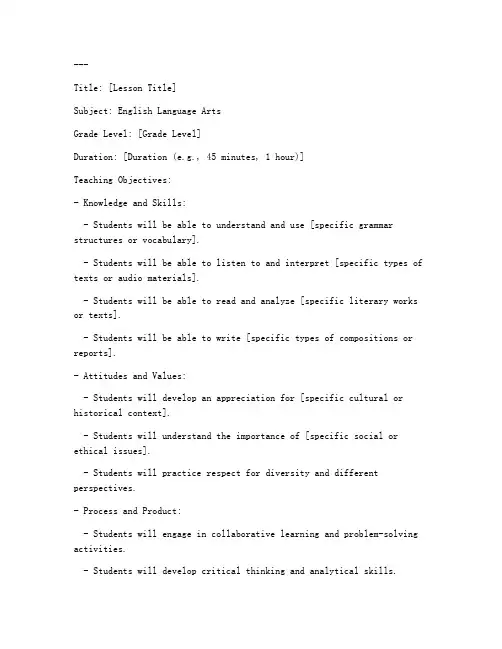
---Title: [Lesson Title]Subject: English Language ArtsGrade Level: [Grade Level]Duration: [Duration (e.g., 45 minutes, 1 hour)]Teaching Objectives:- Knowledge and Skills:- Students will be able to understand and use [specific grammar structures or vocabulary].- Students will be able to listen to and interpret [specific types of texts or audio materials].- Students will be able to read and analyze [specific literary works or texts].- Students will be able to write [specific types of compositions or reports].- Attitudes and Values:- Students will develop an appreciation for [specific cultural or historical context].- Students will understand the importance of [specific social or ethical issues].- Students will practice respect for diversity and different perspectives.- Process and Product:- Students will engage in collaborative learning and problem-solving activities.- Students will develop critical thinking and analytical skills.- Students will demonstrate their learning through [specific assessments or projects].Materials:- Textbooks or handouts- Whiteboard or projector- Audio/visual materials (videos, podcasts, etc.)- Computers or tablets- Handouts or worksheets- Writing materials (pens, paper, etc.)Preparation:- Ensure all materials are ready and organized.- Familiarize yourself with the lesson content and any technical aspects.- Prepare any additional resources or activities that may be needed.- Set up the classroom environment to facilitate the learning process.Introduction (5 minutes):- Begin with a brief review of previous lesson material to activateprior knowledge.- Introduce the new lesson topic with a relevant hook (e.g., a question, a short video clip, or a real-life scenario).- Explain the objectives and structure of the lesson clearly to the students.Main Activity (20-25 minutes):- Engage Students:- Use a variety of activities to engage students in the learning process (e.g., group discussions, pair work, role-plays).- Incorporate interactive elements such as games or technology-based tasks.- Demonstrate Skills:- Provide explicit instruction on the target language features or skills.- Use examples and models to illustrate the correct usage.- Practice and Application:- Have students practice the new skills in controlled activities.- Provide opportunities for students to apply their knowledge in real or simulated contexts.- Assessment:- Monitor student progress during activities and provide immediate feedback.- Use formative assessments to check understanding and adjust instruction as needed.Conclusion (5-10 minutes):- Summarize the key points of the lesson.- Encourage students to reflect on what they have learned and how it relates to their own lives.- Provide any additional resources or homework assignments for further practice.Assessment:- Formative Assessment:- Observe student participation and engagement.- Use informal checks-for-understanding (e.g., exit tickets, short quizzes).- Provide individual or group feedback during and after activities.- Summative Assessment:- Assign a written or oral assignment that reflects the learning objectives.- Use quizzes, tests, presentations, or projects to assess students' overall understanding.Reflection:- After the lesson, reflect on what worked well and what could be improved.- Consider how the lesson objectives were met and whether the students were able to achieve the desired learning outcomes.- Make notes for future lessons or modifications to the current lesson plan.---This template is designed to be flexible and adaptable to various teaching contexts and objectives. It ensures that the lesson is well-structured, student-centered, and focused on achieving the intended learning outcomes.。
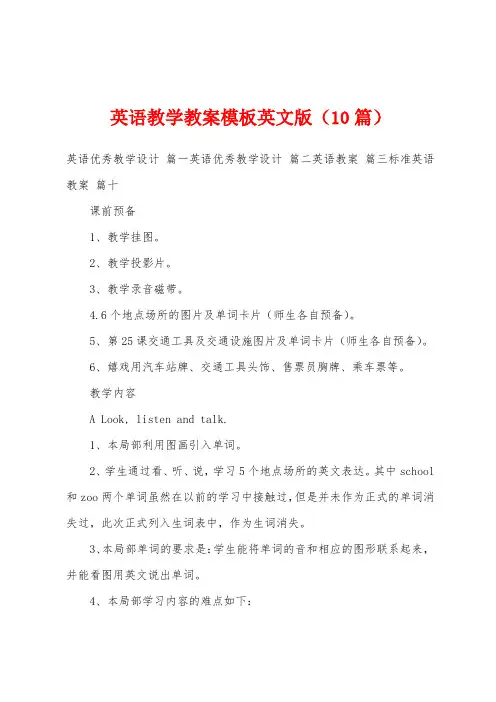
英语教学教案模板英文版(10篇)英语优秀教学设计篇一英语优秀教学设计篇二英语教案篇三标准英语教案篇十课前预备1、教学挂图。
2、教学投影片。
3、教学录音磁带。
4.6个地点场所的图片及单词卡片(师生各自预备)。
5、第25课交通工具及交通设施图片及单词卡片(师生各自预备)。
6、嬉戏用汽车站牌、交通工具头饰、售票员胸牌、乘车票等。
教学内容A Look, listen and talk.1、本局部利用图画引入单词。
2、学生通过看、听、说,学习5个地点场所的英文表达。
其中school 和zoo两个单词虽然在以前的学习中接触过,但是并未作为正式的单词消失过,此次正式列入生词表中,作为生词消失。
3、本局部单词的要求是:学生能将单词的音和相应的图形联系起来,并能看图用英文说出单词。
4、本局部学习内容的难点如下:(1)book store词组中失去爆破的读音;(2)地点及场所单词词义的识别。
5、初步练习用“Where are you going? Im going to.。
.。
”语句,询问某人要去哪儿和表达自己要去的地方。
6、初步练习询问某人乘坐什么交通工具并能答复。
7、本局部重点学习地点及场所单词的音、形、义/对语句的学习仅要求能初步感知,在B局部教学中应留意进展语句的稳固练习。
8、本局部能够涉及到的复习内容是:询问某物在哪儿的语句及表示方位的词。
此项复习内容为第27课学习指路和问路做了铺垫。
B Lets play and say.1、本局部的学习内容是学生通过嬉戏的方式进展模拟角色表演。
2、学生通过用语言做事情,娴熟把握所学地点场所的单词和询问某人要去哪儿的问答语。
3、本局部有一首关于开着车去某地方的。
歌曲,此歌曲协作学生模拟活动,不要求学生会唱,可以在今后的复习稳固中要求学生逐步学会此歌曲。
教学建议1、学生在学习新内容之前,教师应帮忙学生对第25课的学习内容进展复习。
2、教师出示教学挂图,请学生看图并听录音。
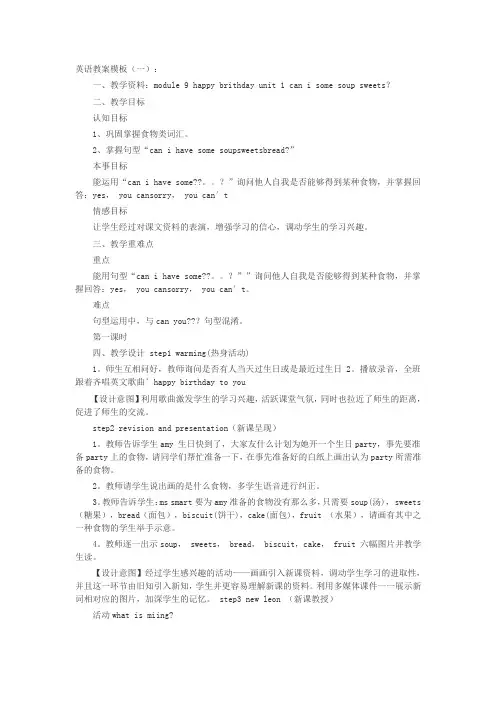
英语教案模板(一):一、教学资料:module 9 happy brithday unit 1 can i some soup sweets?二、教学目标认知目标1、巩固掌握食物类词汇。
2、掌握句型“can i have some soupsweetsbread?”本事目标能运用“can i have some??。
?”询问他人自我是否能够得到某种食物,并掌握回答:yes, you cansorry, you can′t情感目标让学生经过对课文资料的表演,增强学习的信心,调动学生的学习兴趣。
三、教学重难点重点能用句型“can i have some??。
?””询问他人自我是否能够得到某种食物,并掌握回答:yes, you cansorry, you can′t。
难点句型运用中,与can you???句型混淆。
第一课时四、教学设计 step1 warming(热身活动)1。
师生互相问好,教师询问是否有人当天过生日或是最近过生日 2。
播放录音,全班跟着齐唱英文歌曲’happy birthday to you【设计意图】利用歌曲激发学生的学习兴趣,活跃课堂气氛,同时也拉近了师生的距离,促进了师生的交流。
step2 revision and presentation(新课呈现)1。
教师告诉学生amy 生日快到了,大家友什么计划为她开一个生日party,事先要准备party上的食物,请同学们帮忙准备一下,在事先准备好的白纸上画出认为party所需准备的食物。
2。
教师请学生说出画的是什么食物,多学生语音进行纠正。
3。
教师告诉学生:ms smart要为amy准备的食物没有那么多,只需要soup(汤), sweets (糖果),bread(面包),biscuit(饼干),cake(面包),fruit (水果),请画有其中之一种食物的学生举手示意。
4。
教师逐一出示soup, sweets, bread, biscuit,cake, fruit 六幅图片并教学生读。
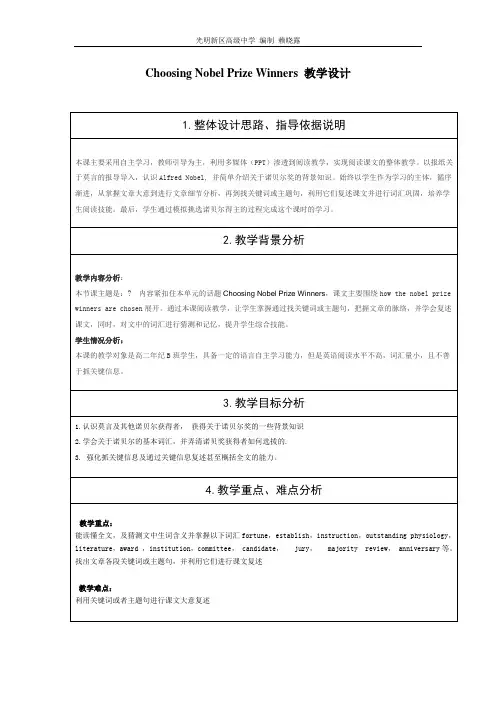
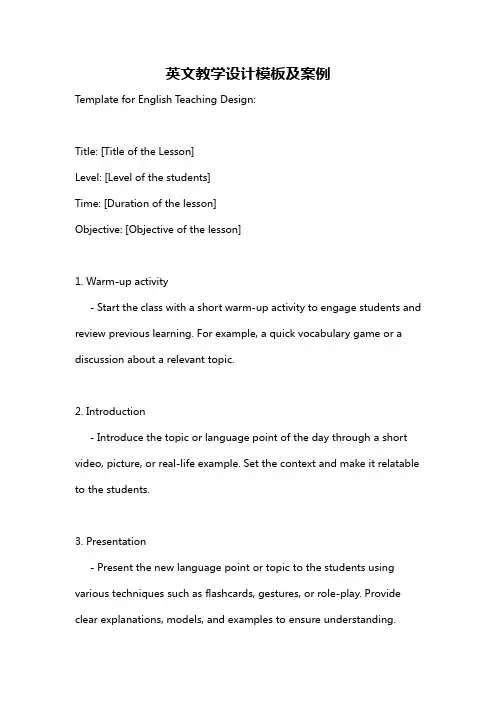
英文教学设计模板及案例Template for English Teaching Design:Title: [Title of the Lesson]Level: [Level of the students]Time: [Duration of the lesson]Objective: [Objective of the lesson]1. Warm-up activity- Start the class with a short warm-up activity to engage students and review previous learning. For example, a quick vocabulary game or a discussion about a relevant topic.2. Introduction- Introduce the topic or language point of the day through a short video, picture, or real-life example. Set the context and make it relatable to the students.3. Presentation- Present the new language point or topic to the students using various techniques such as flashcards, gestures, or role-play. Provide clear explanations, models, and examples to ensure understanding.4. Practice- Engage students in practice activities to reinforce the new language or topic. These could include individual, pair, or group activities such as fill-in-the-blanks, completing sentences, or creating dialogues.5. Production- Provide opportunities for students to produce the language or demonstrate their understanding. This could be through discussions, debates, writing tasks, or presentations.6. Feedback and correction- Provide constructive feedback and correction throughout the lesson and at the end of activities. Encourage students to self-correct and peer-correct to foster independent learning.7. Wrap-up activity- End the lesson with a fun and interactive activity to reinforce the learning and bring closure to the topic. This could be a game, a quiz, or a short reflection activity.8. Homework- Assign relevant homework tasks that consolidate the learning from the lesson. This could include worksheet exercises, reading assignments, or online practice.Sample Lesson:Title: Describing PeopleLevel: IntermediateTime: 60 minutesObjective: By the end of the lesson, students will be able to accurately describe physical appearance and personality.1. Warm-up activity- Play a short video clip or show pictures of different celebrities and ask students to describe their physical appearance and speculate on their personality.2. Introduction- Introduce the topic of describing people by showing pictures of a famous person and asking students to describe their appearance and personality based on the picture.3. Presentation- Present adjectives to describe physical appearance and personality through flashcards or pictures. Provide clear explanations, drill pronunciation, and give examples of usage.4. Practice- Pair up students and provide them with a set of pictures of different people. Students take turns describing the physical appearance and personality of the person in the picture to their partner.5. Production- Divide the class into small groups and assign each group a celebrity or a person from a picture. Students in each group discuss and create a detailed description of the person, including physical appearance and personality, and present it to the class.6. Feedback and correction- Provide feedback and correction on students' descriptions during the production activity. Encourage self-correction and peer-correction.7. Wrap-up activity- Play a game such as "Guess Who?" where students have to guess aperson based on the description given by their classmates.8. Homework- Assign students to write a short paragraph describing a friend or a family member, focusing on physical appearance and personality.。
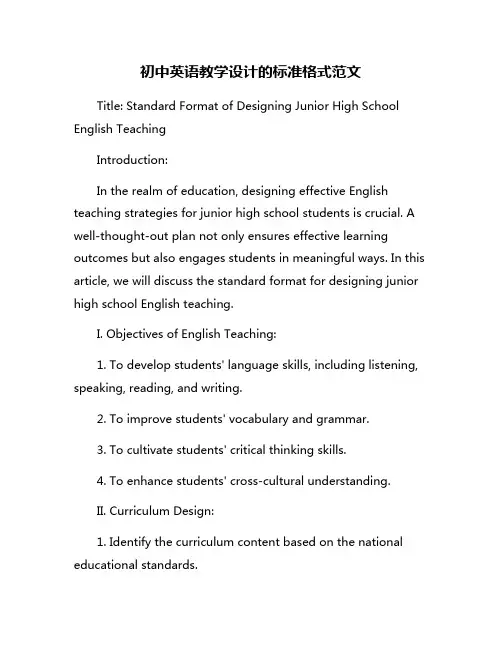
初中英语教学设计的标准格式范文Title: Standard Format of Designing Junior High School English TeachingIntroduction:In the realm of education, designing effective English teaching strategies for junior high school students is crucial. A well-thought-out plan not only ensures effective learning outcomes but also engages students in meaningful ways. In this article, we will discuss the standard format for designing junior high school English teaching.I. Objectives of English Teaching:1. To develop students' language skills, including listening, speaking, reading, and writing.2. To improve students' vocabulary and grammar.3. To cultivate students' critical thinking skills.4. To enhance students' cross-cultural understanding.II. Curriculum Design:1. Identify the curriculum content based on the national educational standards.2. Break down the curriculum content into manageable units, such as themes or topics.3. Plan lesson sequences to ensure a coherent and progressive learning experience.4. Incorporate diverse teaching materials, including textbooks, audiovisual aids, and online resources.III. Lesson Planning:1. Include clear learning objectives for each lesson.2. Plan engaging activities to facilitate students' participation.3. Integrate various teaching methods, such as group work, pair work, and discussions.4. Allocate time for formative assessments to monitor students' progress.IV. Assessment:1. Design assessments that align with the learning objectives.2. Include a mix of formative and summative assessments.3. Provide timely feedback to students to support their learning.4. Use assessment data to inform teaching practices and adjust the curriculum as needed.V. Classroom Management:1. Create a positive and inclusive learning environment.2. Establish clear expectations for student behavior.3. Utilize effective classroom management strategies to address disruptions.4. Foster a sense of community and collaboration among students.Conclusion:Designing effective English teaching for junior high school students requires careful planning and implementation. By following the standard format outlined in this article, educators can create engaging and meaningful learning experiences for their students. Ultimately, the goal is to equip students with the language skills and critical thinking abilities they need to succeed in an increasingly globalized world.。
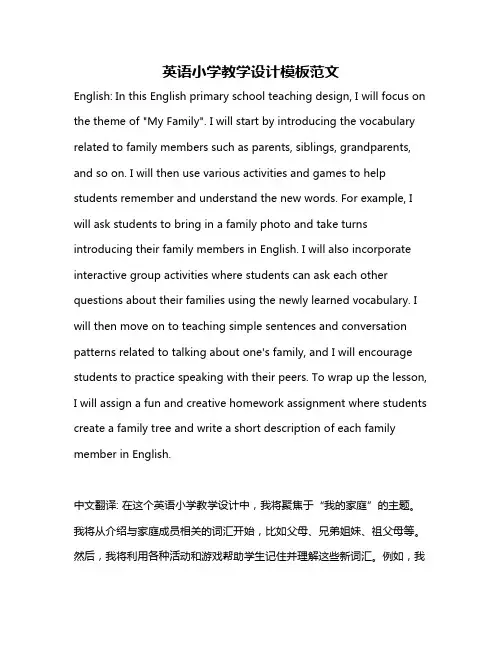
英语小学教学设计模板范文English: In this English primary school teaching design, I will focus on the theme of "My Family". I will start by introducing the vocabulary related to family members such as parents, siblings, grandparents, and so on. I will then use various activities and games to help students remember and understand the new words. For example, I will ask students to bring in a family photo and take turns introducing their family members in English. I will also incorporate interactive group activities where students can ask each other questions about their families using the newly learned vocabulary. I will then move on to teaching simple sentences and conversation patterns related to talking about one's family, and I will encourage students to practice speaking with their peers. To wrap up the lesson, I will assign a fun and creative homework assignment where students create a family tree and write a short description of each family member in English.中文翻译: 在这个英语小学教学设计中,我将聚焦于“我的家庭”的主题。
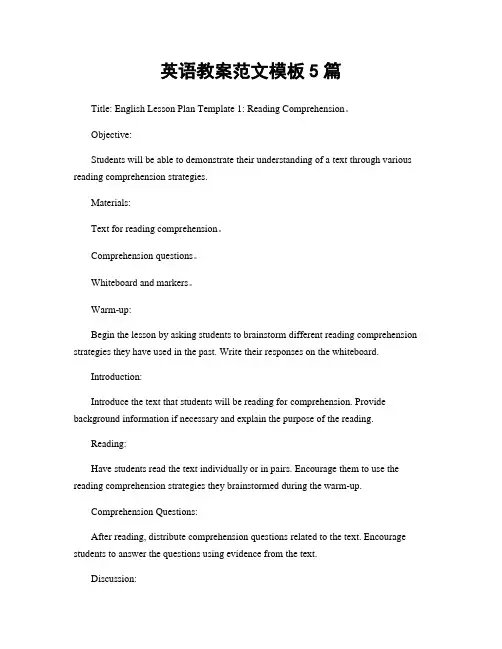
英语教案范文模板5篇Title: English Lesson Plan Template 1: Reading Comprehension。
Objective:Students will be able to demonstrate their understanding of a text through various reading comprehension strategies.Materials:Text for reading comprehension。
Comprehension questions。
Whiteboard and markers。
Warm-up:Begin the lesson by asking students to brainstorm different reading comprehension strategies they have used in the past. Write their responses on the whiteboard.Introduction:Introduce the text that students will be reading for comprehension. Provide background information if necessary and explain the purpose of the reading.Reading:Have students read the text individually or in pairs. Encourage them to use the reading comprehension strategies they brainstormed during the warm-up.Comprehension Questions:After reading, distribute comprehension questions related to the text. Encourage students to answer the questions using evidence from the text.Discussion:Lead a class discussion about the text and the comprehension questions. Encourage students to share their answers and explain their reasoning.Extension Activity:For an extension activity, have students write a short summary of the text or create a visual representation (such as a poster or a drawing) to demonstrate their understanding.Assessment:Assess students' understanding based on their responses to the comprehension questions, their participation in the discussion, and their extension activity.Closure:Conclude the lesson by reviewing the reading comprehension strategies that students used and discussing how they can apply these strategies to other texts.Title: English Lesson Plan Template 2: Vocabulary Building。
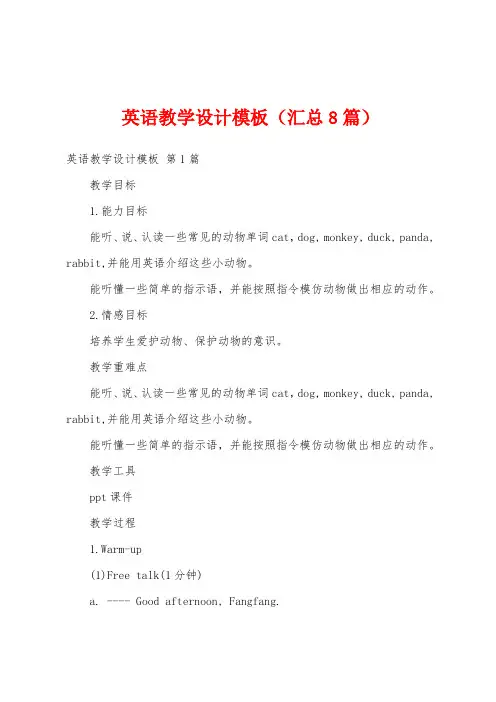
英语教学设计模板(汇总8篇)英语教学设计模板第1篇教学目标1.能力目标能听、说、认读一些常见的动物单词cat,dog, monkey, duck, panda, rabbit,并能用英语介绍这些小动物。
能听懂一些简单的指示语,并能按照指令模仿动物做出相应的动作。
2.情感目标培养学生爱护动物、保护动物的意识。
教学重难点能听、说、认读一些常见的动物单词cat,dog, monkey, duck, panda, rabbit,并能用英语介绍这些小动物。
能听懂一些简单的指示语,并能按照指令模仿动物做出相应的动作。
教学工具ppt课件教学过程1.Warm-up(1)Free talk(1分钟)a. ---- Good afternoon, Fangfang.---- Good afternoon, Lanlan.b. ---- Hello, Xiaoling. How are you?---- Hi, I'm fine, thank you. And you?---- Very well, thank you.(2)播放歌曲Teddy Bear(要求学生边拍手边吟唱,营造一个欢乐活泼的英语气氛。
)(1分钟)(3)大小声游戏:rabbit, monkey, panda, zoo(1分钟)教师轻声说一个单词,学生则需大声朗读。
教师大声说,学生则轻声说。
(设计思路:活跃气氛,融洽师生情感,激发学生参与课堂活动的热情,使学生迅速进入英语学习的状态,并帮助学生巩固了上节课的单词。
)2.Presentation教师课前在黑板上用彩色粉笔画一个动物园的图案。
(1)教学ducka.教师画一个duck的简笔画,微笑着问学生:Hello, boys and girls. What's this? Do you know?你们认识它吗?它的叫声是怎样的呢?b.课件出现duck的画面及叫声T: Look at my mouth. d-u-c-k, d-u-c-k (注意元音字母u的发音)然后把图片鸭子贴在黑板上。

英语教案格式模板范文英语教案格式模板范文【篇一:全英文英语教案模板】lesson plannsefc module2 unit reading in teacher:period:period1 type:readingduration: 45minutesteaching ideologythe current theory view reading as a interactive process which involves not only the printed page but also the reader’s old knowledge of the language in general, the world and the text types. in the reading process, these factors interact with each other and compensate for each other. based on the understanding of reading as an interactive process, teaching reading in the classroom is divided into three stages in which the top-down and bottom-up techniques integrated to develop the students language efficiency in general and reading strategies. the three stages are pre-reading, while-reading and post-reading.teaching material and learning conditionthe analysis of teaching materialthe teaching material is the reading part from nsefc module2 unit. the topic of this unit is . this passage mainly introduces the passage consists of paragraphs. the first paragraph is a general introduction of the . para.2 to para.4 introduces . the last paragraph tells about . the topic is not new to the ss. but there is some new words and phases in the passage.the analysis of learning conditionthe students are from grade1 in senior high school. as high school students, they have achieved certain english level and they have the ability to get the basic idea of the reading. since they are in grade1, they are easily activated and want to air their own opinions on the topic. they are familiar with the topic of and know some. but they may not know before. moreover, their vocabulary is limited so they may have difficulties in understanding some sentences.learning objectives1. language skills? at the beginning of the class, ss can predict the content of the passage based on the title. ? ss can scan the passage and find out the specific information such as the person related with? ss can summarize the passage with the help of the clues of the passage.2. language knowledge? ss can master the key words and phrases of the passage as follows, . ? ss can learn , especially3. affects? ss will realize that and they will concern themselves with the issue of4. cultural awareness? ss will broaden their minds by knowing something about5. learning strategies? ss will cultivate their ability individual learning and cooperative learning by doing someactivities independently and some in groups.? ss will communicate with each other in english while doing the group work.language difficultiesfocuses and anticipatedlanguage focusesthis is a reading period so the focus is to cultivate the students’ reading skills. the many activities are designed to help ss to train their reading skills, such as predicting, skimming, scanning and summarizing.it is also important for the ss to master the new words and phrases.anticipated difficultiesas the ss have a limited vocabulary, so they may have some difficulties in understanding the passage. so the teacher will help them learn the new words and phrases.ss may did not heard before, so the teacher will tell them some background knowledge about it.teaching methodthree-stage model: based on the understanding of reading as an interactive process, teaching reading in the classroom is divided into three stages in which the top-down and bottom-up techniques integrated to develop the students language efficiency in general and reading strategies. the three stages are pre-reading, while-reading and post-reading.teaching aidsmultimedia devices and ppt documents: in order to help ss to fully understand the whole passage, i adopt multimedia devices and ppt documents to bring the real-life situation into the classroom.teaching proceduresstep1. lead-in (6min)activity1. greetings and free-talking (2min)t leads into the topic by asking ss some they know. ss tell the name of the they know freely.t: hello boys and girls. (ss say hello to the teacher.)t: when we say , what appears in your minds? (ss tell the things appear in their minds freely.) t: what are the ? (ss tell some names of .)activity2. picture-talking (4min)t shows some pictures about the in china and abroad. after seeing the pictures, ss are expected to tell the similarities of them.t: just now, you talk about some in china. no w, let’s see some pictures of some . (t shows the pictures and ss see them carefully.)t: what do the have in common?for example, they are very precious. what are your opinions?(t gives them some hints and ss tell the characteristics of )[aims]? in this step, t first leads in the topic by talking with the ss freely about the whichis familiar to them and then ss see some pictures and tell the characteristics. these two activities aim to arouse the ss’ interests in the topic and activate their old knowledge of . then ss will be mentally prepared for the reading comprehension. what’s more,when they are talking about the charateristics of, they will realize that theare rare and precious and they will concern themselves with the issue of .step2. pre-reading (3min)activity1. knowing something about (1min)t gives a brief introduction of the. ss will know the t: today, we are going to learn . it is . do you know what is? (t shows some pictures ofand ss get to know the .)activity2. predicting (2min)t asks ss to read the title of the passage and then ask them some questions. ss will predict the content of the passage with the help of the title.t: please look at the title “”, what does “” mean?(if the ss can not give the answer, then t explain it.)t: in search means that people are looking for it. why are people looking for it? can you guess? what will the passage talk about?(ss predict the content, but t will not give the answer here.) [aims]in this step, the ss first know some information of the ; the background information will make it easier for the ss to understand the passage. then t asks ss to make predictions about the passage. it aims to help ss develop the reading skills of predicting.step3. while-reading (22min)activity1. skimming (4min)ss skim the whole passage and find out and check their predictions. t: why are people still ? here is a multiple choice for you.activity2. scanning (3min)t presents several true or false statements and asks the ss to scan the passage and judge the right from the wrong.(keys: F,F,T,T,F)activity3 close-reading (15min)t designs various kinds of activities and ss do the activities to fully understand the passage. para.1t: please read para.1 carefully and then take some note about the .para.2-4please read para.2-4 carefully and then find out the removal of the room.please read para.2-4 carefully and then find out the person related with the amber room and the things them down with it. para.5please read para.5 carefully and then find out the the rebuilding of the amber room.【篇二:初中英语教学设计模板】初中英语教学设计模板【篇三:初中英语教案(格式规范版)】云南省教师资格认定考试教育教学能力测试教学方案姓名:张俊利资格种类:初中教师资格任教科目:英语《what’s the highest mountain in the world?》teaching plan[the basic information]1.subject:english2.topic:what’s the highest mountain in the world?3.class:grade 84.the teacher:zhang junli5. type of lesson:new lesson6. theaching hour:one class hour7.teaching aid:multi-media[teaching objectives]1. knowledge objectivenew words : qomolangma,the nile, the caspian sea, the sahara ,square, kilometer ,desert ,populationphrases: in size,in the word, meters deep/long/high,as...as, the biggest population. sentence: what’s the highest mountain in the world?how long is qomolangma?it’s 8,844.43 meters high. it’s higher than any other mountain. which is the deepest salt lake in the world? the caspian sea is the deepest of all the salt lake.did you know that china is one of the oldest countries in the world? yes, i did. it’s much older than the us.2. ability objectivelet the students can understand and talk about the topic of geography and natural. master the usage of the comparative and superlative. 3. emotion objectiveto cultivate the students love the nature, make them have the consciousness of protecting the environment.[teaching main and difficult points]1. teaching main pointsuse comparative and superlative forms of adjective and adverbs 2. teaching difficult points1talk about the geography and nature using comparative and superlative forms of adjective and adverbs.the contrast between the object.[teaching methods][teaching procedures]step1.leading-in1. watch the photos and talk about them “howbig/high/long/big is …?’ and help the students to answer:it’s …meters/kilometers/cm big/high/long/big. 2. look these photos and practice the dialogue: e.g. a: how high is qomolangma?b: it’s 8,844 meters high.step 2. match the facts you know. practice in pairs using the information in 1a.step 3 explaination…8,844 meters high.8,844米高… meters high (long,wide…) ……米高(长,宽……)。
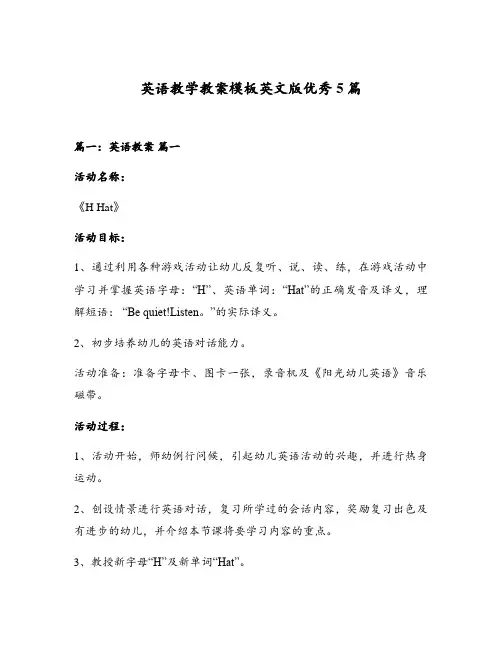
英语教学教案模板英文版优秀5篇篇一:英语教案篇一活动名称:《H Hat》活动目标:1、通过利用各种游戏活动让幼儿反复听、说、读、练,在游戏活动中学习并掌握英语字母:“H”、英语单词:“Hat”的正确发音及译义,理解短语:“Be quiet!Listen。
”的实际译义。
2、初步培养幼儿的英语对话能力。
活动准备:准备字母卡、图卡一张,录音机及《阳光幼儿英语》音乐磁带。
活动过程:1、活动开始,师幼例行问候,引起幼儿英语活动的兴趣,并进行热身运动。
2、创设情景进行英语对话,复习所学过的会话内容,奖励复习出色及有进步的幼儿,并介绍本节课将要学习内容的重点。
3、教授新字母“H”及新单词“Hat”。
(1)教师出示字母娃娃H,让幼儿说出像什么,在拼贴字母的过程中学会字母“H”的正确发音。
(2)教师利用图卡引出“帽子”的英语单词,通过游戏“贴帽子”让幼儿反复练习强化,逐渐掌握单词“Hat”的正确发音及译义。
4、律动教学。
教授幼儿短语“Be quiet!Listen。
”的实际译义及相应的动作。
5、教师小结,叮嘱幼儿:“回家要看VCD,回家要听录音机,回家要当Melody!”篇二:高中英语教学设计篇二一、课程类型:高三复习课二、教学目标:一) 认知目标1、句型和语言点(见教学重点)。
2、用所学的知识与伙伴进行交流、沟通,学会改错、写作。
二)情感目标利用多媒体手段营造积极和谐教学氛围,使学生不自觉地进入情景之中,充分调动学生的思维活动和情感体验,引起学生的共鸣。
三)智力目标在运用语言的过程中培养学生的观察力、分析力、想象力和自学能力,帮助学生加强记忆力,提高思维能力和运用英语的综合能力,激发创造能力。
三、教材分析:这是高三复习阶段的一节写作课。
这节书面表达课就从审题谋篇等方面入手来完成教学目的,侧重于引导学生在把握书面表达的写作前准备即谋篇审题能力,使学生在动手写作前迅速构思按照规范的模式来完成谋篇审题:在教学中不仅仅强调写,对于与写作紧密联系的听、说、读、改错都有兼顾。
英语教学设计模板优秀8篇英语优秀教学设计篇一教学目标知识与技能目标1、Get students to learn some useful new words and expressions in this part.2、Get students to read the letter.3、Let students learn the prohibition, warning and permission.过程与方法目标1、Develop students’ reading skills and enable them to learn how to use different reading strategies to read different reading materials.2、Enable student s to understand how to give advice.情感态度与价值观目标1、Stimulate students’ interests of learning English by reading and acting this play.2、Develop students’ sense of group cooperation and teamwork.教学重点1.state the main idea of each paragraph in own words2.ways to bee addicted to cigarettes3.the harmful effects of smoking4、suggestions to quit smoking教学难点1、sorting out major idea and minor idea2、master key words in key sentence教学过程→Step 1 Warming upShow some proverbs on health1.An apple a day keeps the doctor away.2.Early to bed and early to rise, makes a man healthy, wealthy and wise.→Step 2 Skimming1How many parts does the reading text consist of?2、Who wrote the letter to whom?3、How many ways can a man bee addicted to smoking?→Step 3 Scanning1、The first sentence of the letter shows James granddad______ 。
英语教案模板10篇英语教案模板10篇英语教案模板(一):课题:______课时:______课型:______(新授课复习课检查课)(一)教学目标1。
知识与技能(1)能听、说、认读______等单词,并能在日常生活中使用。
(2)能听懂、会说______等句子,并在实际情景中运用。
(3)了解西方______(如,节日、风俗等)的有关知识。
2。
过程与方法(1)能经过图画动作的提示,听懂读懂简单的短句小故事。
(2)经过主角表演小组活动,增强表达和交流本事。
(3)能初步使用简单的英汉词典,辅助学习。
3。
情感态度与价值观(1)培养学生听英语、说英语的兴趣,增强学生学习英语的信心。
(2)使学生意识到学习英语的重要意义。
(3)培养学生的______情感习惯。
(与课题相关,如爱护环境)(二)教学重难点1。
教学重点______单词的听、说、认读。
2。
教学难点(1)单词_____等的发音。
(2)句型______在实际情景中的运用。
(3)语法______的掌握。
(三)教学过程1。
热身准备经过歌曲视频游戏的方式,导入新课。
2。
呈现新知,合作互动(1)教师以卡片形式逐一呈现单词:______,听录音,模仿单词的升降调发音。
[由整理](2)挑选个别学生展示单词的发音,及时纠正发音,表扬和鼓励学生,培养学生大胆说的习惯。
(3)以教师领读,学生跟读,小组展示等多种形式展开学习。
(4)教师读句子,让学生在语境中感受单词______的意思及用法。
(5)播放班班通,让学生整体感受课文的资料。
(6)教师讲解、领读课文资料,让学生根据教师设计的问题做出相应的回答。
并在情景中感受短语单词______的意思。
(7)整体齐读,结合小组展示等多种形式,加强学生朗读的本事的培养。
3。
巩固新知,拓展练习(1)结合生活情境,设计游戏______,用所学的单词或短语进行简单的交际。
(2)模仿范例写句子。
4。
课堂延伸(1)听录音,读、背单词、句子。
(2)在生活中使用所学单词、句子。
Title: [Subject/Topic] Lesson PlanObjective(s):- To [specific objective 1].- To [specific objective 2].- To [specific objective 3].Materials:- [List of materials needed for the lesson, e.g., textbooks, worksheets, multimedia resources, etc.]Duration:- [Total time required for the lesson, e.g., 45 minutes, 1 hour.]Introduction (5 minutes):- Greeting: Begin with a greeting to establish a positive learning environment.- Review: Briefly review previous learning to ensure students have a foundation for the new material.- Introduction to the Topic: Introduce the topic clearly and concisely, using any relevant visuals or materials.Teaching Procedures:1. Presentation (10 minutes):- Explain the main concepts using clear language and examples.- Utilize visual aids, such as slides, charts, or videos, to enhance understanding.- Engage students with questions to check for understanding.2. Activity (15 minutes):- Interactive Activity: Engage students in an activity that reinforces the lesson objectives, such as a group discussion, a role-play, or a hands-on experiment.- Practice Exercise: Provide a practice exercise for students to apply what they have learned. This could be a worksheet, a game, or a small project.3. Group Work (15 minutes):- Divide the class into small groups and assign a task that requires collaboration and application of the lesson material.- Circulate among the groups to provide assistance and ensure that all students are actively participating.4. Feedback and Assessment (5 minutes):- Collect student work or provide feedback on the group work.- Ask students to reflect on what they have learned and how they can apply it in future learning.Conclusion (5 minutes):- Summary: Summarize the key points of the lesson.- Homework: Assign homework that reinforces the lesson objectives and provides additional practice.- Next Class: Briefly preview the next lesson or topic to maintain continuity.Assessment:- Formative Assessment: Throughout the lesson, use questioning, observations, and student work to assess understanding.- Summative Assessment: At the end of the lesson or unit, use quizzes, tests, or projects to evaluate student learning.Extension Activities:- For Advanced Students: Provide additional reading materials, more challenging problems, or enrichment projects.- For Struggling Students: Offer additional support through one-on-one tutoring, alternative assignments, or review sessions.Adaptations for Diverse Learners:- For Students with Special Needs: Modify activities to accommodate different learning styles and abilities.- For English Language Learners: Use simple language, visual aids, and sentence frames to support comprehension.V范文Title: Introduction to GeometryObjective(s):- To introduce students to basic geometric shapes and their properties.- To help students understand the terms 'congruent' and 'similar'.- To develop spatial reasoning skills through practical activities.Materials:- Geometry textbooks- Colored paper- Scissors- Rulers- Markers- Geometric shape templatesDuration:- 1 hourIntroduction (5 minutes):- Greeting and review of previous lesson on shapes.- Introduction to the topic: "Today, we are going to explore the fascinating world of geometry!"Teaching Procedures:1. Presentation (10 minutes):- Explain the properties of basic geometric shapes (triangle, quadrilateral, circle, etc.).- Use a whiteboard to draw and label shapes, emphasizing key terms like vertices, edges, and angles.2. Activity (15 minutes。
教学设计的英语作文模板Certainly, here's a structured English essay template for instructional design:---。
Title: [Title of the Essay]Introduction:The introduction serves to provide context and background information on the topic. It should include a thesis statement that outlines the main argument or purpose of the essay.Thesis Statement: 。
In this essay, we will explore [topic] and its significance in [context].Body Paragraphs:The body paragraphs should elaborate on the main points of the essay, providing evidence, examples, and analysis to support the thesis statement. Each paragraph should focus on a specific aspect or subtopic related to the main idea.Paragraph 1: Introduction to the Topic。
Begin by defining the topic and its relevance. Provide background information and any necessary context to help the reader understand the significance of the topic.Paragraph 2: Main Point 1。
Subject: English Language ArtsGrade Level: [e.g., Grade 6]Class Duration: [e.g., 45 minutes]Teaching Objectives:1. Knowledge Objectives:- Students will be able to understand and use key vocabulary related to [topic].- Students will be able to construct sentences using [specific grammar structure].2. Skill Objectives:- Students will improve their listening skills by comprehending spoken English on the topic.- Students will enhance their speaking skills by participating in role-plays and group discussions.3. Emotional and Moral Objectives:- Students will develop an interest in [topic] and its related cultural aspects.- Students will learn to appreciate diversity and express their opinions respectfully.Teaching Aids:- Whiteboard/Smartboard- Projector/Computer- Handouts- Audio/Video materials- Props (if necessary)Teaching Procedure:I. Introduction (5 minutes)- Greet the students and check if they are prepared for the lesson.- Briefly introduce the topic and its relevance.- Engage the students with a question or a brief activity related to the topic.II. Warm-up (5 minutes)- Conduct a brief activity to activate prior knowledge, such as a quick vocabulary quiz or a brainstorming session.- Use a song, a riddle, or a game to warm up the students and make them more receptive to learning.III. Listening and Comprehension (10 minutes)- Play a short audio clip or a video related to the topic.- Ask the students to listen and answer comprehension questions.- Provide feedback and clarify any misunderstandings.IV. Vocabulary Building (10 minutes)- Introduce new vocabulary related to the topic.- Use pictures, gestures, or realia to help students understand the meanings.- Have students practice using the new words in sentences.V. Grammar Practice (10 minutes)- Explain the grammar structure that will be focused on in this lesson.- Provide examples and model the usage.- Have students practice with exercises or activities.VI. Speaking and Interaction (10 minutes)- Conduct a role-play activity based on the topic.- Organize a group discussion to encourage students to express their opinions.- Circulate and provide feedback, focusing on pronunciation, fluency, and content.VII. Consolidation and Review (5 minutes)- Summarize the key points of the lesson.- Ask the students to share what they have learned.- Provide additional resources or homework for further practice.VIII. Homework Assignment (2 minutes)- Assign relevant homework that reinforces the lesson's objectives.- Encourage students to continue their learning outside the classroom.IX. Assessment- Evaluate student participation and performance throughout the lesson.- Use formative assessments such as exit tickets, quizzes, or oral presentations.Reflection:- After the lesson, reflect on the effectiveness of the teaching methods used and make adjustments for future lessons.- Consider the students' feedback and how it can be used to improve the learning experience.Note: This template can be adapted to fit different teaching styles, learning objectives, and classroom environments.。
一、模板1. 教学目标- 知识目标- 能力目标- 情感目标2. 教学重难点- 重点- 难点3. 教学方法- 启发式教学 - 案例分析法 - 任务型教学 - 情景教学法4. 教学过程- 导入- 基础知识讲解 - 实践环节- 总结与反思5. 教学评价- 学生自评- 同伴互评- 教师评价二、范文课题:Unit 1 My New Teacher一、教学目标1. 知识目标- 学生能够正确拼读单词:teacher, classroom, student, etc.- 学生能够理解并运用句型:This is my teacher. He/She is a good teacher.2. 能力目标- 学生能够听懂并模仿教师的指令。
- 学生能够运用所学知识进行简单的对话。
3. 情感目标- 学生能够积极参与课堂活动,热爱英语学习。
二、教学重难点1. 重点- 单词的拼读和句型的运用。
2. 难点- 学生能够运用所学知识进行简单的对话。
三、教学方法1. 启发式教学:通过提问引导学生思考,激发学生的学习兴趣。
2. 案例分析法:通过分析典型例句,帮助学生理解句型。
3. 任务型教学:通过设置任务,让学生在完成任务的过程中运用所学知识。
4. 情景教学法:通过创设情境,让学生在真实的语境中运用所学知识。
四、教学过程1. 导入- 教师用英语进行自我介绍,引出课题。
- 学生用英语进行自我介绍,为接下来的学习做准备。
2. 基础知识讲解- 教师讲解单词的拼读和句型的运用。
- 学生跟读,巩固所学知识。
3. 实践环节- 学生进行小组活动,运用所学知识进行对话。
- 教师巡视指导,纠正学生的发音和语法错误。
4. 总结与反思- 学生总结所学知识,分享学习心得。
- 教师点评学生的表现,提出改进意见。
五、教学评价1. 学生自评:学生对本节课的学习情况进行自我评价。
2. 同伴互评:学生之间互相评价,指出对方的优点和不足。
3. 教师评价:教师对本节课的教学效果进行评价,并提出改进措施。
教案背景:1. 学生情况:高二学生2. 学科:英语3. 课时:一课时4. 课前准备:教师方面:(1)认真分析教材,根据学生的水平设计好导学案(见学案附录)。
(2)认真备课,设计好课堂内的各个环节和活动。
本节课的教学内容是英文诗歌,为增加趣味性,激发学生的兴趣,活跃课堂,我使用了英文歌谣(关键词:Twinkle,twinkle, little star)的视频材料。
(3)整合教学资源,精心设计PPT。
学生方面:(1)预习课文,完成导学案自学部分。
(2)使用百度搜索引擎查找与英文诗相关的材料,进一步了解英文诗的相关知识。
关键词:English poems (英文诗)nursery thymes (童谣) list poems (清单诗)cinquain(五行诗)haiku (俳句)tang pems(唐诗)。
教学课题:高中英语选修六第二单元Poems教材分析:(注:含本课时在本单元的教学定位分析)本单元的教学内容是诗歌欣赏。
文中涉及诗歌的韵律、节奏,并介绍了几种不同内容和形式的简单诗歌。
本节课时旨在引导学生讨论这些内容,目的在于让他们了解诗歌的一些基本特征和写作方法,自己尝试写简单的诗歌,体验创作的快乐,并会欣赏这些优美的文学作品。
本课阅读文结合学生的实际,简要介绍了几种简单英文诗:饶有童趣的英文童谣、富有生活气息的清单诗、简单易学的五行诗、短小精悍的日本俳句及中国古代著名的唐诗。
使学生欣赏诗歌,感受体会诗歌之美、文学之美、语言之美,并掌握相关的诗歌知识,从而激发他们的创作欲望和热情。
本课以“人们为什么要写诗?“”诗歌的特点是什么?“为线索,以导学案,多媒体教学为辅助手段,使学生感受到诗歌的魅力。
教学方法:任务型教学法、小组合作讨论竞争法教学目标分析知识与能力目标:了解英文诗歌的一些常识,并在此基础上创作诗歌。
(Get to know the basic knowledge about poetry and learn to write poems.)方法与过程:通过听、朗读、小组合作讨论和竞争展示达成目标。
(Listening, reading., group cooperation,competition and presentation.情感目标:培养起对英文诗歌的兴趣,欣赏英文诗之美。
(Enjoy the beauty of English poems and develop an interest in poetry.)教学重点、难点分析教学重点:欣赏英文诗歌,了解英文诗的类型,韵律和节奏。
教学难点:尝试自己创作英文诗歌。
教学过程设计步骤1:课前热身准备Step I: Enjoy an English song.(课前英文歌欣赏)设计意图:用英文诗歌调动起学生的学习积极性。
步骤2:导入新课Step II: Lead-in 约5分钟(视频记忆中的童谣导入)T: Class begins, good morning, everyone! Class, When you were a baby, your mum always sang beautiful and soft songs while you were asleep in her arms. Now, Le t’s recall a nursery rhyme and then you can tell me your feeling.(播放视频)Ss and teacher clap and sing the nrusery rhyme together.T: What’s your feeling?Ss: I feel happy, familiar and it reminds me of my childhood.T: Yes. Nursery rhymes are often used to make a baby asleep and teach him language. They belong to poems. Now, please think about two questions:1) What else can we get from poems? 2)Why do people write poems?And in this class we will enjoy 5 kinds of poems and you can get the answers.First, let’s look at the learning aims.设计意图:通过听儿歌,一起唱儿歌,激起学生对英文诗歌的兴趣,引出学习目标。
步骤3:带着任务听课文录音Step III: Listening practice 约7分钟(根据每一首诗设定的不同任务进行听力训练,欣赏诗歌)T: Look at the screen and listen to the tape,and pay attention to your tasks(幻灯片要求):Pome 1: Sing after the tape and clap the beat.(Ss clap the beat)听第一首诗歌,打节拍。
Pome 2:Read after and pay attention to the phrases and subjunctive mood.(Read after and line down the subjunctive mood sentences)跟读诗歌并画出其含有的虚拟语气句式。
Pome 3:Close your eyes and imagine the picture in your mind.(describe the pictures after listening)闭上眼睛,勾勒出诗歌描绘的画面。
Pome 4:Translate it into Chinese (Translate the poem ensitively) 把诗歌翻译成汉语,并富含激情地朗诵出来。
设计意图:(每一首诗歌听前都设计了不同的任务,有打节奏,画语法点,想象画面和翻译)通过根据不同的任务听诗歌,在欣赏诗歌的同时也锻炼了学生的听读能力。
步骤4:自主学习: Step 4: Self-studyScanning (扫读):请学生快速阅读教材并完成导学案Task I.Carefull Reading(细读):完成导学案TaskII。
步骤5:小组合作探究Step IV: Discussion , presentation &comments 10分钟(学生讨论展示点评学案合作探究部分)T: Please discuss the questions in groups and then show your answers. The group leader of each groupshould control the process and all of you should pay attention to the demands.谈论完成学案探究问题幻灯片打出讨论要求:内容:自主学习部分:unsolved questions合作探究部分:口头展示Task I 书面展示Task II要求:1.小组内先一对一讨论, 然后组内合作讨论. 动口动脑动笔2.组长调控好,确保每一层次的学生都能最大限度解决问题,以备展示和质疑,保证高效完成。
3. 组长协助组BC 层做好展示、点评、拓展准备。
幻灯片展示分工及要求:展示内容 展示小组及方式 点评小组How to find out the topic sentence?口头自由展示补充质疑 TaskI T1-3口头自由展示 TaskII G1,2,5,7书面展示 G4,9展示点评要求:1.书面展示同学脱稿展示,认真书写,答案力求简洁、规范。
2.口头展示及点评同学声音洪亮,教态自然,注意补充、拓展。
3.非展示点评同学拿好红笔随时修改自己的答案, 并及时提出质疑。
( While the students are discussing, show the tasks on the screen ,and the students of the four groups come to the Bb to write down their answers after their discussion. The other students can read the poems loudly) T: Good. Just now, all of you have made a heated discussion. It is time to make a comment about the answers on the Bb.S1: (come to the front and make a comment and mark the result) I think the handwriting is …..and the answer is ….Igive it … Any more questions? Thanks you. (掌声)S2:…T: Very good. Let ’s come to the rest tasks . If you know the answers just stand up and share your opinions with us. Le t’s come to No. 1…..S1: My answe is …S2: I have a different opinion. I think ….S3: I want to add more about it ….T: Good. Any more questions about the passage?S1: I don ’t understand the the sentence in line 31……Who can help me?S2: I think …..设计意图:通过小组内的合作探究和展示和点评,在让他们集思广益,自己欣赏诗歌的同时又锻炼学生的自主学习和团队合作能力。
步骤5:质疑疑难StepV: Questioning 3分钟(质疑并回答一上课提出的问题)T: Just now, all of you have done a very good job. Any unsolved questions about the passage?Ss :(质疑解答)…..T: Can you answe my question now: Why do people write poems? And What can we get from poems?Ss: I think …Ss: I want to say more. I think….T: Good.People write poems to tell a story; to express feelings; to make others laugh; to tell the life or friendship; to delight the kids;to describe the seasons or scenes. From poems we can get passion to our life;Poems help us to understand life, virtues(美德),beauty and romance.(幻灯片打出其他答案)设计意图:通过学生的质疑,发现未解决的疑难点(文中的涉及的语法“虚拟语气“),老师作进一步补充。